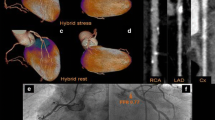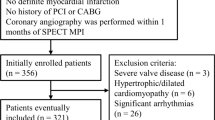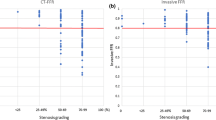Abstract
Objective
Combination of both morphological and functional information has gained more and more appreciation with the concept of “functionally relevant coronary artery lesion (FRCAL)” and “functional revascularization”. This has paved the way for non-invasive single-photon emission computed tomography (SPECT)/computed tomography angiography (CTA) hybrid imaging. We aimed at assessing the value of cardiac hybrid imaging on the detection of FRCAL and its potential as a gatekeeper for invasive examination and treatment.
Methods
In Two hundred and thirty-eight patients with known or suspected coronary artery disease (CAD) underwent CTA and myocardial perfusion imaging (MPI) using SPECT on a dual system scanner in one session before treatment. 78 patients underwent invasive coronary angiography (CAG) within 1 month. Detection of FRCAL by the combination of SPECT/CTA was compared with SPECT/CAG, which served as a standard of reference. According to the both combination results, treatment decision (revascularization or medical treatment) was chosen in the catheterization laboratory.
Results
Sensitivity, specificity, accuracy, positive and negative prediction rate by SPECT/CTA vs. SPECT/CAG for the detection of flow-limiting coronary stenosis on patient- and vessel-based analysis were 94.33, 72.00, 87.18, 87.71, 85.71 % and 88.71, 92.44, 91.45, 80.89, 95.78 %, respectively. No revascularization procedures were performed in patients without flow-limiting stenosis. However, more than one-third (25/67, 37 %) of revascularized vessels were not associated with ischemia on MPI.
Conclusions
The cardiac SPECT/CTA hybrid imaging can accurately detect FRCAL and thereby it may be used as a gatekeeper for CAG and revascularization procedures.


Similar content being viewed by others
References
Kaufmann PA. Cardiac hybrid imaging: state-of-the-art. Ann Nucl Med. 2009;23:325–31.
Miller JM, Rochitte CE, Dewey M, Arbab-Zadeh A, Niinuma H, Gottlieb I, et al. Diagnostic performance of coronary angiography by 64-row CT. N Engl J Med. 2008;359:2324–36.
Gaemperli O, Schepis T, Kalff V, Namdar M, Valenta I, Stefani L, et al. Validation of new cardiac image fusion software for three-dimensional integration of myocardial perfusion SPECT and stand-alone 64-slice CT angiography. Eur J Nucl Med Mol Imaging. 2007;34:1097–106.
Tonino PA, De Bruyne B, Pijls NH, Siebert U, Ikeno F, van’t Veer M, et al. Fractional flow reserve versus angiography for guiding percutaneous coronary intervention. N Engl J Med. 2009;360:213–24.
Pijls NH, van Schaardenburgh P, Manoharan G, Boersma E, Bech JW, van’t Veer M, et al. Percutaneous coronary intervention of functionally nonsignificant stenosis: 5-year follow-up of the DEFER Study. J Am Coll Cardiol. 2007;49:2105–11.
Kadokami T, Ando S, Momii H, Yoshida M, Narita S, Fukunaga T, et al. Diagnostic performance of cardiac fusion images from myocardial perfusion imaging and multislice computed tomography coronary angiography for assessment of hemodynamically significant coronary artery lesions: an observational study. Nucl Med Commun. 2012;33:60–8.
Schaap J, de Groot J, Nieman K, Meijboom W, Boekholdt S, Van der Heyden J, et al. Advanced Imaging in Assessment of CAD & Atherosclerosis Treatment decisions based on hybrid myocardial perfusion SPECT and CT coronary angiography. J Nucl Med. 2012;53(Supplement 1):243.
Judkins MP. Percutaneous transfemoral selective coronary arteriography. Radiol Clin N Am. 1968;6:467–92.
Judkins MP. Selective coronary arteriography. I. A percutaneous transfemoral technic. Radiology. 1967;89:815–24.
Gaemperli O, Husmann L, Schepis T, Koepfli P, Valenta I, Jenni W, et al. Coronary CT angiography and myocardial perfusion imaging to detect flow-limiting stenoses: a potential gatekeeper for coronary revascularization? Eur Heart J. 2009;30:2921–9.
Windecker S, Remondino A, Eberli FR, Juni P, Raber L, Wenaweser P, et al. Sirolimus-eluting and paclitaxel-eluting stents for coronary revascularization. N Engl J Med. 2005;353:653–62.
Sun D, Wang J, Tian Y, Narsinh K, Wang H, Li C, et al. Multimodality imaging evaluation of functional and clinical benefits of percutaneous coronary intervention in patients with chronic total occlusion lesion. Theranostics. 2012;2(8):788–800.
Pazhenkottil AP, Nkoulou RN, Ghadri JR, Herzog BA, Küest SM, Husmann L, et al. Impact of cardiac hybrid single-photon emission computed tomography/computed tomography imaging on choice of treatment strategy in coronary artery disease. Eur Heart J. 2011;32:2824–9.
Pazhenkottil AP, Nkoulou RN, Ghadri JR, Herzog BA, Buechel RR, Küest SM, et al. Prognostic value of cardiac hybrid imaging integrating single-photon emission computed tomography with coronary computed tomography angiography. Eur Heart J. 2011;32:1465–71.
Flotats A, Knuuti J, Gutberlet M, Marcassa C, Bengel FM, Kaufmann PA, Cardiovascular Committee of the EANM, the ESCR and the ECNC, et al. Hybrid cardiac imaging: SPECT/CT and PET/CT. A joint position statement by the European Association of Nuclear Medicine (EANM), the European Society of Cardiac Radiology (ESCR) and the European Council of Nuclear Cardiology (ECNC). Eur J Nucl Med Mol Imaging. 2011;38:201–12.
Schindler TH, Magosaki N, Jeserich M, Oser U, Krause T, Fischer R, et al. Fusion imaging: combined visualization of 3D reconstructed coronary artery tree and 3D myocardial scintigraphic image in coronary artery disease. Int J Card Imaging. 1999;15:357–68 (discussion 369–70).
Rispler S, Aronson D, Abadi S, Roguin A, Engel A, Beyar R, et al. Integrated SPECT/CT for assessment of haemodynamically significant coronary artery lesions in patients with acute coronary syndrome. Eur J Nucl Med Mol Imaging. 2011;38:1917–25.
Santana CA, Garcia EV, Faber TL, Sirineni GK, Esteves FP, Sanyal R, et al. Diagnostic performance of fusion of myocardial perfusion imaging and computed tomography coronary angiography. J Nucl Cardiol. 2009;16:201–11.
Pazhenkottil AP, Herzog BA, Husmann L, Buechel RR, Burger IA, Valenta I, et al. Non-invasive assessment of coronary artery disease with CT coronary angiography and SPECT: a novel dose-saving fast-track algorithm. Eur J Nucl Med Mol Imaging. 2010;37:522–7.
Achenbach S, Marwan M, Ropers D, Schepis T, Pflederer T, Anders K, et al. Coronary computed tomography angiography with a consistent dose below 1 mSv using prospectively electrocardiogram-triggered high-pitch spiral acquisition. Eur Heart J. 2010;31:340–6.
Author information
Authors and Affiliations
Corresponding author
Additional information
This work was supported by the Capital Medical Development Scientific Research Fund (2007–3089) and the Capital Medical University affiliated Beijing Anzhen Hospital Dean Technology Development Fund (2010C01).
Rights and permissions
About this article
Cite this article
Dong, W., Wang, Q., Gu, S. et al. Cardiac hybrid SPECT/CTA imaging to detect “functionally relevant coronary artery lesion”: a potential gatekeeper for coronary revascularization?. Ann Nucl Med 28, 88–93 (2014). https://doi.org/10.1007/s12149-013-0790-9
Received:
Accepted:
Published:
Issue Date:
DOI: https://doi.org/10.1007/s12149-013-0790-9




